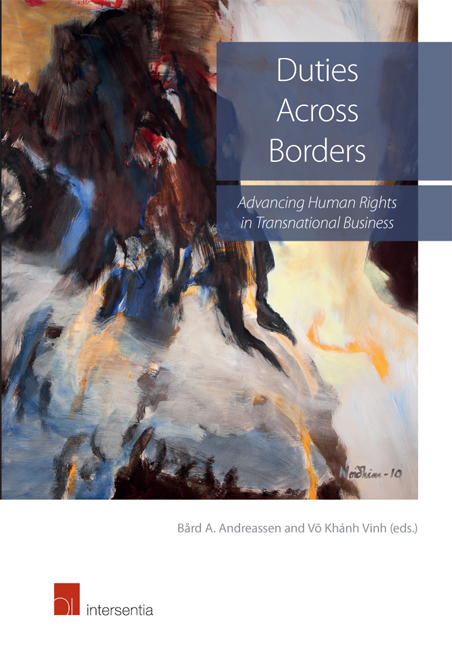Book contents
- Frontmatter
- Preface
- Contents
- List of Authors
- List of Figures and Tables
- Introduction. Business’ Duties Across Borders: The New Human Rights Frontier
- Part I. Conceptual Developments
- Chapter 1 Business and Human Rights, or the Business of Human Rights. Critical Reflections on Emerging Themes
- Chapter 2 Corporate Liability for Human Rights. Effective Remedies or Ineffective Placebos
- Chapter 3 Ensuring the Protection of the Environment from Serious Damage. Towards a Model of Shared Responsibility between International Corporations and the States Concerned?
- Chapter 4 The Business Case for Taking Human Rights Obligations Seriously
- Chapter 5 Corporate Accountability in the Field of Human Rights. On Soft Law Standards and the Use of Extraterritorial Measures
- Chapter 6 The Viability of the Maastricht Principles in Advancing Socio-Economic Rights in Developing Countries
- Part II Contextual Issues
- Part III Sites Of Regulation
Chapter 1 - Business and Human Rights, or the Business of Human Rights. Critical Reflections on Emerging Themes
from Part I. Conceptual Developments
Published online by Cambridge University Press: 21 September 2018
- Frontmatter
- Preface
- Contents
- List of Authors
- List of Figures and Tables
- Introduction. Business’ Duties Across Borders: The New Human Rights Frontier
- Part I. Conceptual Developments
- Chapter 1 Business and Human Rights, or the Business of Human Rights. Critical Reflections on Emerging Themes
- Chapter 2 Corporate Liability for Human Rights. Effective Remedies or Ineffective Placebos
- Chapter 3 Ensuring the Protection of the Environment from Serious Damage. Towards a Model of Shared Responsibility between International Corporations and the States Concerned?
- Chapter 4 The Business Case for Taking Human Rights Obligations Seriously
- Chapter 5 Corporate Accountability in the Field of Human Rights. On Soft Law Standards and the Use of Extraterritorial Measures
- Chapter 6 The Viability of the Maastricht Principles in Advancing Socio-Economic Rights in Developing Countries
- Part II Contextual Issues
- Part III Sites Of Regulation
Summary
‘Business and human rights’ is a vast field touching upon almost anything that one could think of – from footballs to free trade, pollution to prostitution, torture to terror, oil spills to outsourcing, child labour to climate change, sweatshops to surveillance, extraterritoriality to employment, investment to Internet censorship, due diligence to discrimination, corruption to conflict minerals, and poverty to privacy. As it will be a herculean task for me to cover such a wide canvass in one chapter, I aim to reflect only on selected emerging themes in this area. This chapter will focus on the following four themes: the business case for human rights; the work of Professor John Ruggie as the UN Secretary General's Special Representative on the issue of human rights and transnational corporations (SRSG); behaviour of spineless states in regulating corporate conduct impinging upon human rights; and the US Supreme Court judgment in theKiobel case.
However, rather than dealing with them as a laundry list, I wish to weave an argument around these themes. In short, the argument is that most of the key players in the domain of business and human rights have not taken human rights seriously. Taking human rights seriously should have entailed imposing legally binding human rights obligations on all business enterprises and putting in place an enforcement mechanism to ensure adherence to these rights by private actors. Instead of working to achieve these goals, the key players have often employed the human rights discourse to serve other interests. I will call this exercise of treating human rights not an end in itself but only means to attain certain other objectives as the ‘business of human rights’, because whether (and to what extent) human rights are to be respected depends primarily on the potential impact of doing so on maximising profits or serving other interests.
Who are the key players in the area of business and human rights that I am referring to here? The key players are multinational corporations (MNCs) and their representative organisations, states, courts, international institutions, non-governmental organisations (NGOs), trade unions, media organisations, consumers, investors, lawyers and of course scholars. Several of these players are linked to the four themes taken up in this chapter. The first theme – the business case for human rights – engages not only companies but also drivers behind the business case such as consumers, investors, the media, and NGOs.
- Type
- Chapter
- Information
- Duties Across BordersAdvancing Human Rights in Transnational Business, pp. 23 - 38Publisher: IntersentiaPrint publication year: 2016

